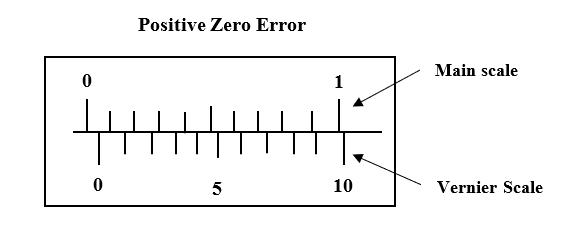
The zero error of a Vernier is +1. Its zero correction is (take L.C.= 0.01 cm)
A. 0.2 cm
B. -0.2 cm
C. -0.02 cm
D. +0.02 cm
Answer
548.1k+ views
Hint: When the zero on the main scale does not coincide with the zero on the Vernier scale then it is known as Zero error for Vernier. The smallest value the Verner can measure is known as Least count. Zero error correction depends on the least count of the instrument as well as on the zero error. To calculate the zero correction of the Vernier, multiply the least count with the zero error. But, the zero error is positive so take the negate of the product of least count and zero error. This obtained value will be the zero correction.
Complete answer:


Given: Least Count (L.C.)= 0.01 cm
Zero error (Z)= +1
Zero Correction is given by,
$Correction= -(L.C. \times Z) cm$
Substituting values in above equation we get,
$Correction= -(0.01 \times 1) cm$
$\Rightarrow Correction= -0.01 cm$
Hence, the zero correction is -0.01 cm.
So, the correct answer does not match the given options.
Note:
There are two types of zero error namely positive zero error and negative zero error. When the main scale coincides with a number greater than zero on the Vernier scale then it is positive zero error and if it coincides with a number lower than the zero then it is a negative zero error. Students must understand that the least count of typical Vernier calipers are the same but the zero error does not remain the same. Sometimes, there might be no zero error in the instrument. Students must also keep in mind that when the zero error is positive, it is subtracted from the total reading and if it is negative then it is added.
Complete answer:


Given: Least Count (L.C.)= 0.01 cm
Zero error (Z)= +1
Zero Correction is given by,
$Correction= -(L.C. \times Z) cm$
Substituting values in above equation we get,
$Correction= -(0.01 \times 1) cm$
$\Rightarrow Correction= -0.01 cm$
Hence, the zero correction is -0.01 cm.
So, the correct answer does not match the given options.
Note:
There are two types of zero error namely positive zero error and negative zero error. When the main scale coincides with a number greater than zero on the Vernier scale then it is positive zero error and if it coincides with a number lower than the zero then it is a negative zero error. Students must understand that the least count of typical Vernier calipers are the same but the zero error does not remain the same. Sometimes, there might be no zero error in the instrument. Students must also keep in mind that when the zero error is positive, it is subtracted from the total reading and if it is negative then it is added.
Recently Updated Pages
Which cell organelles are present in white blood C class 11 biology CBSE

What is the molecular geometry of BrF4 A square planar class 11 chemistry CBSE

How can you explain that CCl4 has no dipole moment class 11 chemistry CBSE

Which will undergo SN2 reaction fastest among the following class 11 chemistry CBSE

The values of mass m for which the 100 kg block does class 11 physics CBSE

Why are voluntary muscles called striated muscles class 11 biology CBSE

Trending doubts
One Metric ton is equal to kg A 10000 B 1000 C 100 class 11 physics CBSE

Discuss the various forms of bacteria class 11 biology CBSE

Explain zero factorial class 11 maths CBSE

State the laws of reflection of light

Difference Between Prokaryotic Cells and Eukaryotic Cells

Show that total energy of a freely falling body remains class 11 physics CBSE




